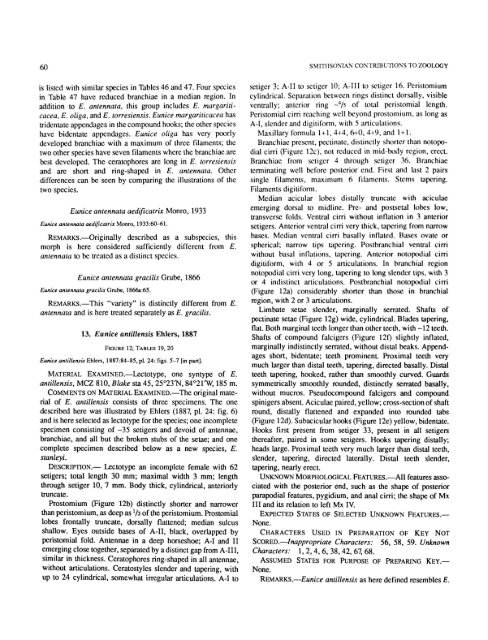A Review of the Genus Eunice - Smithsonian Institution Libraries
A Review of the Genus Eunice - Smithsonian Institution Libraries
A Review of the Genus Eunice - Smithsonian Institution Libraries
You also want an ePaper? Increase the reach of your titles
YUMPU automatically turns print PDFs into web optimized ePapers that Google loves.
60 SMITHSONIAN CONTRIBUTIONS TO ZOOLOGY<br />
is listed with similar species in Tables 46 and 47. Four species<br />
in Table 47 have reduced branchiae in a median region. In<br />
addition to E. antennata, this group includes E. margariticacea,<br />
E. oliga, and E. lorresiensis. <strong>Eunice</strong> margariticacea has<br />
tridentate appendages in <strong>the</strong> compound hooks; <strong>the</strong> o<strong>the</strong>r species<br />
have bidentate appendages. <strong>Eunice</strong> oliga has very poorly<br />
developed branchiae with a maximum <strong>of</strong> three filaments; <strong>the</strong><br />
two o<strong>the</strong>r species have seven filaments where <strong>the</strong> branchiae are<br />
best developed. The ceratophores are long in E. torresiensis<br />
and are short and ring-shaped in E. antennata. O<strong>the</strong>r<br />
differences can be seen by comparing <strong>the</strong> illustrations <strong>of</strong> <strong>the</strong><br />
two species.<br />
<strong>Eunice</strong> antennata aedificatrix Monro, 1933<br />
<strong>Eunice</strong> antennata aedificatrix Monro, 1933:60-61.<br />
REMARKS.—Originally described as a subspecies, this<br />
morph is here considered sufficiently different from E.<br />
antennata to be treated as a distinct species.<br />
<strong>Eunice</strong> antennata gracilis Grube, 1866<br />
<strong>Eunice</strong> antennata gracilis Grube, 1866a:65.<br />
REMARKS.—This "variety" is distinctly different from E.<br />
antennata and is here treated separately as E. gracilis.<br />
13. <strong>Eunice</strong> antillensis Ehlers, 1887<br />
FIGURE 12; TABLES 19,20<br />
<strong>Eunice</strong> antillensis Ehlers, 1887:84-85, pi. 24: figs. 5-7 [in part].<br />
MATERIAL EXAMINED.—Lectotype, one syntype <strong>of</strong> E.<br />
antillensis, MCZ 810, Blake sta 45, 25°23'N, 84°21'W, 185 m.<br />
COMMENTS ON MATERIAL EXAMINED.—The original material<br />
<strong>of</strong> E. antillensis consists <strong>of</strong> three specimens. The one<br />
described here was illustrated by Ehlers (1887, pi. 24: fig. 6)<br />
and is here selected as lectotype for <strong>the</strong> species; one incomplete<br />
specimen consisting <strong>of</strong> -35 setigers and devoid <strong>of</strong> antennae,<br />
branchiae, and all but <strong>the</strong> broken stubs <strong>of</strong> <strong>the</strong> setae; and one<br />
complete specimen described below as a new species, E.<br />
stanleyi.<br />
DESCRIPTION.— Lectotype an incomplete female with 62<br />
setigers; total length 30 mm; maximal width 3 mm; length<br />
through setiger 10, 7 mm. Body thick, cylindrical, anteriorly<br />
truncate.<br />
Prostomium (Figure 12b) distinctly shorter and narrower<br />
than peristomium, as deep as l /2 <strong>of</strong> <strong>the</strong> peristomium. Prostomial<br />
lobes frontally truncate, dorsally flattened; median sulcus<br />
shallow. Eyes outside bases <strong>of</strong> A-II, black, overlapped by<br />
peristomial fold. Antennae in a deep horseshoe; A-I and II<br />
emerging close toge<strong>the</strong>r, separated by a distinct gap from A-I 11,<br />
similar in thickness. Ceratophores ring-shaped in all antennae,<br />
without articulations. Ceratostyles slender and tapering, with<br />
up to 24 cylindrical, somewhat irregular articulations. A-I to<br />
setiger 3; A-II to setigcr 10; A-I 11 to setiger 16. Peristomium<br />
cylindrical. Separation between rings distinct dorsally, visible<br />
ventrally; anterior ring ~ A /s <strong>of</strong> total peristomial length.<br />
Peristomial cirri reaching well beyond prostomium, as long as<br />
A-I, slender and digitiform, with 5 articulations.<br />
Maxillary formula 1 + 1, 4+4, 6+0, 4+9, and 1 + 1.<br />
Branchiae present, pectinate, distinctly shorter than notopodial<br />
cirri (Figure 12c), not reduced in mid-body region, erect.<br />
Branchiae from setiger 4 through setiger 36. Branchiae<br />
terminating well before posterior end. First and last 2 pairs<br />
single filaments, maximum 6 filaments. Stems tapering.<br />
Filaments digitiform.<br />
Median acicular lobes distally truncate with aciculae<br />
emerging dorsal to midline. Prc- and posLsetal lobes low,<br />
transverse folds. Ventral cirri without inflation in 3 anterior<br />
setigers. Anterior ventral cirri very thick, tapering from narrow<br />
bases. Median ventral cirri basally inflated. Bases ovale or<br />
spherical; narrow lips tapering. Postbranchial ventral cirri<br />
without basal inflations, tapering. Anterior noiopodial cirri<br />
digitiform, with 4 or 5 articulations. In branchial region<br />
notopodial cirri very long, tapering to long slender tips, with 3<br />
or 4 indistinct articulations. Postbranchial notopodial cirri<br />
(Figure 12a) considerably shorter than those in branchial<br />
region, with 2 or 3 articulations.<br />
Limbate setae slender, marginally serrated. Shafts <strong>of</strong><br />
pectinate setae (Figure 12g) wide, cylindrical. Blades tapering,<br />
flat. Both marginal teeth longer than o<strong>the</strong>r teeth, with -12 teeth.<br />
Shafts <strong>of</strong> compound falcigers (Figure 120 slightly inflated,<br />
marginally indistinctly serrated, without distal beaks. Appendages<br />
short, bidentate; teeth prominent. Proximal teeth very<br />
much larger than distal teeth, tapering, directed basally. Distal<br />
teeth tapering, hooked, ra<strong>the</strong>r than smoothly curved. Guards<br />
symmetrically smoothly rounded, distinctly serrated basally,<br />
without mucros. Pseudocompound falcigers and compound<br />
spinigers absent. Aciculae paired, yellow; cross-section <strong>of</strong> shaft<br />
round, distally flattened and expanded into rounded tabs<br />
(Figure 12d). Subacicular hooks (Figure 12e) yellow, bidentate.<br />
Hooks first present from setiger 33, present in all setigers<br />
<strong>the</strong>reafter, paired in some setigers. Hooks tapering distally;<br />
heads large. Proximal teeth very much larger than distal teeth,<br />
slender, tapering, directed laterally. Distal teeth slender,<br />
tapering, nearly erect.<br />
UNKNOWN MORPHOLOGICAL FEATURES.—All features associated<br />
with <strong>the</strong> posterior end, such as <strong>the</strong> shape <strong>of</strong> posterior<br />
parapodial features, pygidium, and anal cirri; <strong>the</strong> shape <strong>of</strong> Mx<br />
III and its relation to left Mx IV.<br />
EXPECTED STATES OF SELECTED UNKNOWN FEATURES.—<br />
None.<br />
CHARACTERS USED IN PREPARATION OF KEY NOT<br />
SCORED.—Inappropriate Characters: 56, 58, 59. Unknown<br />
Characters: 1, 2, 4, 6, 38, 42, 67, 68.<br />
ASSUMED STATES FOR PURPOSE OF PREPARING KEY.—<br />
None.<br />
REMARKS.—<strong>Eunice</strong> antillensis as here defined resembles E.
















